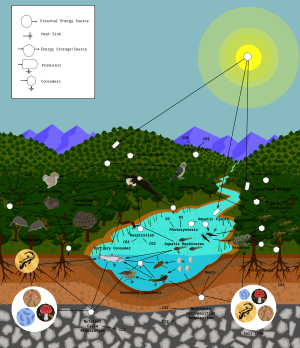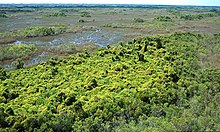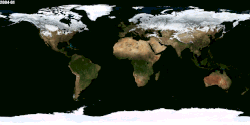
Back بوابة:علم البيئة Arabic Portal:Ecologia Catalan Portal:Økologien Danish Portal:Ecología Spanish درگاه:بومشناسی Persian Portail:Écologie French 포털:생태학 Korean Портал:Екологија Macedonian Portal:Ecologia Portuguese Portal:Ecologie Romanian
| |
|
|
Ecology
|
|
Ecology (from Ancient Greek οἶκος (oîkos) 'house', and -λογία (-logía) 'study of') is the natural science of the relationships among living organisms, including humans, and their physical environment. Ecology considers organisms at the individual, population, community, ecosystem, and biosphere levels. Ecology overlaps with the closely related sciences of biogeography, evolutionary biology, genetics, ethology, and natural history. Ecology is a branch of biology, and is the study of abundance, biomass, and distribution of organisms in the context of the environment. It encompasses life processes, interactions, and adaptations; movement of materials and energy through living communities; successional development of ecosystems; cooperation, competition, and predation within and between species; and patterns of biodiversity and its effect on ecosystem processes. Ecology has practical applications in conservation biology, wetland management, natural resource management (agroecology, agriculture, forestry, agroforestry, fisheries, mining, tourism), urban planning (urban ecology), community health, economics, basic and applied science, and human social interaction (human ecology). The word ecology (German: Ökologie) was coined in 1866 by the German scientist Ernst Haeckel. The science of ecology as we know it today began with a group of American botanists in the 1890s. Evolutionary concepts relating to adaptation and natural selection are cornerstones of modern ecological theory. Ecosystems are dynamically interacting systems of organisms, the communities they make up, and the non-living (abiotic) components of their environment. Ecosystem processes, such as primary production, nutrient cycling, and niche construction, regulate the flux of energy and matter through an environment. Ecosystems have biophysical feedback mechanisms that moderate processes acting on living (biotic) and abiotic components of the planet. Ecosystems sustain life-supporting functions and provide ecosystem services like biomass production (food, fuel, fiber, and medicine), the regulation of climate, global biogeochemical cycles, water filtration, soil formation, erosion control, flood protection, and many other natural features of scientific, historical, economic, or intrinsic value. (Full article...) Selected article - Theoretical ecology is the scientific discipline devoted to the study of ecological systems using theoretical methods such as simple conceptual models, mathematical models, computational simulations, and advanced data analysis. Effective models improve understanding of the natural world by revealing how the dynamics of species populations are often based on fundamental biological conditions and processes. Further, the field aims to unify a diverse range of empirical observations by assuming that common, mechanistic processes generate observable phenomena across species and ecological environments. Based on biologically realistic assumptions, theoretical ecologists are able to uncover novel, non-intuitive insights about natural processes. Theoretical results are often verified by empirical and observational studies, revealing the power of theoretical methods in both predicting and understanding the noisy, diverse biological world. The field is broad and includes foundations in applied mathematics, computer science, biology, statistical physics, genetics, chemistry, evolution, and conservation biology. Theoretical ecology aims to explain a diverse range of phenomena in the life sciences, such as population growth and dynamics, fisheries, competition, evolutionary theory, epidemiology, animal behavior and group dynamics, food webs, ecosystems, spatial ecology, and the effects of climate change. (Full article...)Selected image -Sunflowers were domesticated by humans, and are native to Central America. The evidence thus far is that it was first domesticated in Mesoamerica|, present day Mexico, by at least 2600 BC. It may have been domesticated a second time in the middle Mississippi Valley, or been introduced there from Mexico at an early date, as maize was. Sunflower leaves can be used as a cattle feed, while the stems contain a fiber which may be used in paper production.
General imagesThe following are images from various ecology-related articles on Wikipedia.
Related WikiProjectsThings you can do
Entries here consist of Good and Featured articles, which meet a core set of high editorial standards.
Invasive species in the Everglades are exotic plants and animals that are not native to the area and have aggressively adapted to conditions in wilderness areas in southern Florida. The Everglades are a massive watershed in the southern portion of the U.S. state of Florida that drains overflow from the vast shallow Lake Okeechobee that is in turn fed by the Kissimmee River. The overflow forms a very shallow river about 60 miles (100 km) wide and 100 miles (160 km) long that travels about half a mile per day. The network of ecosystems created by the Everglades are surrounded by urban areas to the east in the South Florida metropolitan area, to the west by Naples and Fort Myers, and to the south by Florida Bay, a marine environment that receives fresh water from and is maintained by the Everglades. As it is surrounded on three sides and close to a major transportation and shipping center, it is particularly vulnerable to the importation of exotic species. In the 20th century, Florida experienced a population surge unparalleled in the U.S., accompanied by rapid urban expansion made possible by draining portions of the Everglades. Flood control became a priority and the Central & South Florida Flood Control Project, from 1947 to 1971, constructed over 1,400 miles (2,300 km) of canals and flood control structures in South Florida. The widespread building created new habitats and disturbed established plant and animal communities. Many of the new residents or tourists in Florida were responsible for introducing plant species to the area by accident, or deliberately to improve landscaping. Many animals have been introduced similarly, and have either escaped or been released to proliferate on their own. Several terms are used to identify non-native species: exotic, invader, immigrant, colonist, introduced, nonindigenous, and naturalized. "Naturalized" usually refers to species that have adapted to a region over a long period of time, while "invasive" refers to particularly destructive or aggressive species. (Full article...)Selected biography - Did you know (auto-generated)
Selected quote -
Ecology news
Additional News Highlights
Selected publication -Polar Research is a journal of the Norwegian Polar Institute, Norway's central institution for research, on the polar regions. The journal's articles are interdisciplinary and encompass a wide range of fields from biology to oceanography. The journal also welcomes socio-economic papers and articles on management. (Full article...) Related portalsMore did you know -Related articlesAssociated WikimediaThe following Wikimedia Foundation sister projects provide more on this subject:
Web resourcesPreview warning: Page using Template:Div col with unknown parameter "1 = 2"; use colwidth= to specify column size
Discover Wikipedia using portals |
© MMXXIII Rich X Search. We shall prevail. All rights reserved. Rich X Search
















































